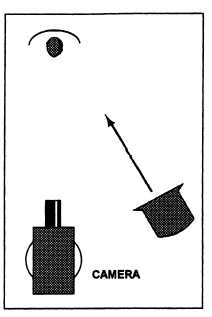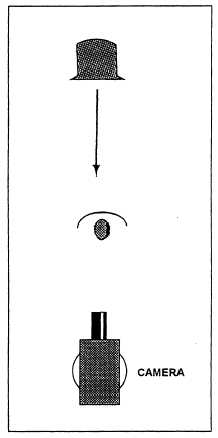Figure 14-28.—Fill light.
degrees. You may eventually make adjustment for any
number of reasons, but this is a good place to start.
Fill Light
The fill light (fig. 14-28) fills in and softens the
harsh shadows created by the key light. Position it on
the opposite side of the camera from the key light and
elevate it 30 to 35 degrees.
Backlight
The backlight (fig. 14-29) is used to separate the
subject from the background by casting a rim of light
across the head and shoulders of the subject. You should
place the backlight at an elevated angle, but be careful
not to light the top of the subject’s head. A good starting
point for the backlight is directly behind the subject,
elevated 30 to 35 degrees. If your light is mounted on a
stand, move it off to the side a little to get the standout
of the picture.
Use of the f/Stop
Like any other camera lens, a television camera lens
produces optimum results when stopped down one or
two stops from its maximum aperture. Depth of field
also is increased by stopping down. Therefore, your
lighting should have sufficient intensity so you can stop
down for the best picture possible.
Figure 14-29.—Backlight.
Proper Lighting Intensity
Lighting in television is as important as lighting in
basic photography. It has both artistic and technical
aspects. Well-planned and executed lighting produces a
clear picture with outstanding contrast and depth.
Most television cameras are capable of operating in
very low-light levels. However, shooting in dim light
may give you video noise and be of generally poor
quality.
Proper Lighting Placement
When you set up lighting for a live television
production, remember that these productions are
continuous; therefore, you must make sure that the
lighting you use will be effective from every angle the
camera sees in the program. You do not have the luxury
of stopping to readjust lighting for each shot. You must
make sure that the lighting fixtures and cables do not
interfere with the free movement of the cameras. As
always, you must plan ahead to avoid embarrassing
pitfalls, and then let your television monitor be your
14-26




